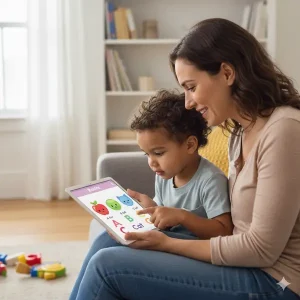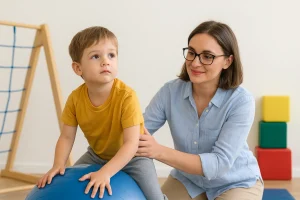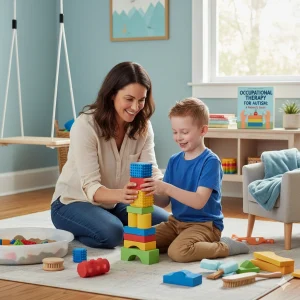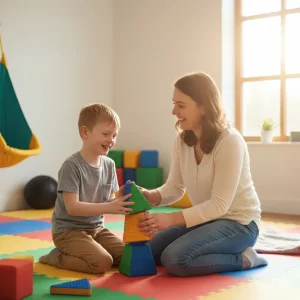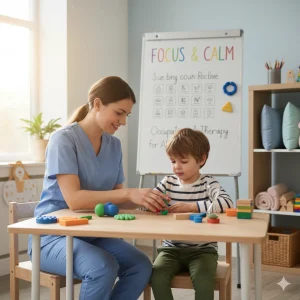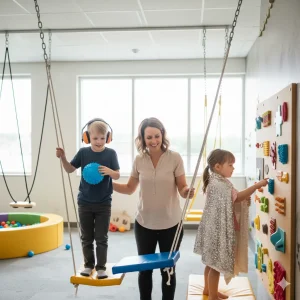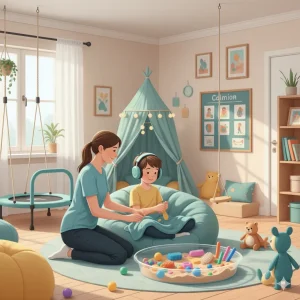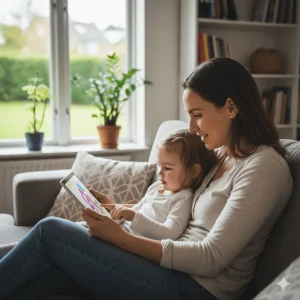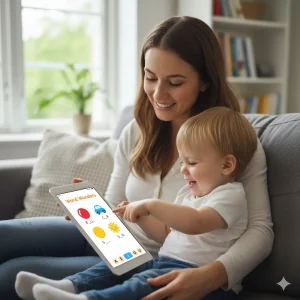Top 5 At-Home Speech Therapy Tools for Toddlers
By Rajini D
Last Updated: June 28, 2025
Is your toddler not talking as much as expected? You’re not alone — and the good news is, you can support your child’s speech right at home. With the right tools and a little daily practice, simple routines like playtime or reading can turn into powerful learning moments. In this article, we’ll share the top 5 expert-recommended speech therapy tools for toddlers, how they work, and how you can use them easily. These tools are fun, parent-friendly, and backed by specialists — including those at Wellness Hub — to help your child take big steps in little ways.
Free Speech Help for Kids
Concerned about speech delays? Book a free consultation with our expert speech therapist and get guidance tailored to your child’s needs.
Why Use Speech Therapy Tools at Home for Toddlers?
If your toddler isn’t talking as much as expected, you’re not alone — and you’re not doing anything wrong. Many parents notice signs of toddler speech delay and start wondering what they can do at home. That’s where speech therapy tools come in.
These tools are simple, everyday items (like flashcards, picture books, or interactive toys) designed to support your child’s speech and language development. But how do they help, and when should you start using them?
Looking for flashcards, activity sheets, or speech therapy games for your child?
Browse our full range of home therapy resources designed by professionals to support speech, behavior, and learning — right from your home.
What Are Speech Therapy Tools?
Speech therapy tools are resources that help children improve their speech, language, and communication skills. They can be physical (like toys or flashcards) or digital (like speech therapy apps or videos).
These tools are often recommended by speech-language pathologists and focus on:
| Type of Tool | Purpose | Example |
|---|---|---|
| Flashcards & Picture Books | Vocabulary, naming, answering questions | Animal cards, storybooks |
| Cause-and-Effect Toys | Requesting, turn-taking, early communication | Pop-up toys, sound buttons |
| Speech Therapy Apps | Interactive learning, repetition | BASICS app by Wellness Hub |
| Visual Aids | Expressive communication, following directions | Routine charts, emotion cards |
Benefits of Using Speech Therapy Tools at Home
You don’t need to be a therapist to help your child talk more. When used right, speech tools can fit naturally into your everyday routines.
Here’s why they’re so helpful:
- Boost brain development through regular interaction
- Reinforce what your child learns in therapy sessions
- Target specific goals (like naming objects or following directions)
- Create bonding moments while learning through play
- Make practice fun and stress-free for both child and parent
When Should Parents Start Using Speech Tools?
Early action = better results.
If your child:
- Isn’t saying any words by 15–18 months
- Only uses a few words at age 2
- Struggles to understand or follow simple instructions
- Seems frustrated trying to express needs
…it may be time to gently introduce at-home speech therapy tools. You don’t need to wait for a diagnosis — starting early can actually reduce the need for more intensive support later.
How Home Practice Supports Faster Progress
Children learn best through repetition and real-life experiences. What your toddler hears and sees at home every day matters — a lot.
By using speech tools regularly at home, you’re:
- Giving your child more chances to practice in a low-pressure setting
- Helping build habits of attention, imitation, and interaction
- Creating a bridge between therapy sessions and daily life
How to Choose the Right Speech Therapy Tools for Toddler
With so many speech therapy tools for toddlers available, it’s easy to feel overwhelmed. Flashcards, talking toys, apps, books — which ones are actually helpful for your child?
The truth is, the best tools are not always the fanciest. What matters most is how well they match your child’s age, skill level, and communication needs.
Let’s walk through how to choose the right toddler language tools step by step.
Age-Appropriate vs Skill-Based Tools: What’s the Difference?
Many parents look for tools based on their child’s age — and while that’s a good starting point, it’s even better to focus on your toddler’s current language skills.
| Tool Type | Best For Age | Best For Skills | Examples |
|---|---|---|---|
| Sound toys & pop-up toys | 1–2 years | Cause-effect, first words | Buttons that make animal sounds |
| Flashcards with real images | 1.5–3 years | Naming, matching | Food, animals, body parts cards |
| Repetitive storybooks | 2–4 years | Combining words | “Brown Bear, Brown Bear” type books |
| Speech therapy apps | 2+ years | Imitation, responding | BASICS app from Wellness Hub |
Tip: Don’t worry about whether your child is “behind.” Focus on what they can do, and choose tools that encourage the next step.
Help your child build early language skills with our expert-designed app, trusted by parents and therapists. Start speech therapy at home — one word at a time.
Download on Android ; Download on iOS
What to Avoid When Picking Speech Materials
Not all toddler speech tools are created equal. Some may look exciting but offer little actual language value.
Avoid tools that:
- Talk at your child without encouraging response (like loud electronic toys)
- Use overly advanced words or complex instructions
- Are too distracting (lights, sounds, and music all at once)
- Don’t allow parent involvement or interaction
Instead, look for tools that invite your child to talk, point, or engage — especially through everyday routines.
Expert Tips from Speech-Language Pathologists (SLPs)
We spoke with several speech therapists from the Wellness Hub team, and here’s what they recommend when choosing toddler speech tools:
- Less is more: One simple toy can do more than a noisy app with 20 buttons.
- Follow your child’s interests: If they love animals, go for animal cards or farm books.
- Use real-life objects when possible: A real spoon or cup can be just as helpful as a picture.
- Involve siblings and parents: The best speech happens during shared play.
And remember — consistency matters more than time. Even 10 minutes a day with the right tool can support steady speech growth.
Top 5 Expert-Backed Speech Therapy Tools for Toddlers
Not sure where to start with at-home speech therapy? These tools are favorites among parents and speech therapists alike — because they’re simple, effective, and toddler-approved. The best part? You can easily use them during everyday routines without needing any special setup.
Here are the 5 best speech therapy tools for toddlers, all backed by child development experts.
1. Flashcards with Real Images
Build vocabulary and comprehension
Flashcards are one of the most recommended tools by speech-language pathologists. When they feature real-life images (instead of cartoons), toddlers can better connect the picture to actual objects around them.
How to use them:
- Ask “What is this?” or “Can you point to the dog?”
- Use them for naming, matching, and describing
- Sort by categories: animals, foods, body parts, emotions
Available in our BASICS app by Wellness Hub – designed to help toddlers build speech through interactive flashcard games with voice prompts and image cues.
2. Interactive Speech Therapy Apps
Engaging, gamified learning that encourages repetition
If your toddler loves screen time, why not make it speech-boosting too?
The best speech therapy apps for toddlers use play-based methods to improve:
- Word repetition
- Listening skills
- Imitation and turn-taking
Look for apps with:
- Bright visuals
- Simple spoken instructions
- Activities like matching, sorting, and naming
3. Cause-and-Effect Toys
Great for early words, requests, and shared play
These toys are perfect for helping toddlers understand that their actions lead to outcomes — a key step in developing speech.
Examples:
- Pop-up toys that open when a button is pressed
- Musical buttons or spinning tops
- Toys that make a sound when touched
How they help:
- Encourage words like “more,” “again,” “go,” or “open”
- Build early turn-taking and social language
- Make requesting fun and natural
Pro tip: Pause before activating the toy and wait for your child to gesture or say a word — this encourages communication.
4. Storybooks with Repetitive Lines
Boosts sentence building and memory through rhythm
Books that repeat phrases (“Brown Bear, Brown Bear, what do you see?”) help toddlers learn sentence patterns and predict language.
Why they work:
- Repetition makes it easier to join in
- Builds memory for sentence structure
- Supports attention and focus
Choose books that are:
- Short and predictable
- Full of visuals and actions
- Easy to sing or chant along with
Add reading into your bedtime routine — even 5 minutes a night can make a difference in early language development.
5. Visual Schedules and Picture Boards
Support expressive speech and help toddlers follow directions
Visuals aren’t just for special needs — they help all toddlers understand routines, choices, and emotions better.
Use them to:
- Show your child what’s happening next
- Offer 2 picture choices (“Do you want milk or juice?”)
- Help with transitions and reduce meltdowns
Visual tools can improve:
- Following directions
- Requesting and choosing
- Describing routines (“I brush teeth”)
You can make your own with printed images, or use built-in tools inside the BASICS platform from Wellness Hub.
Tool Comparison Table
| Tool | Skill Focus | Best Age | How It Helps |
|---|---|---|---|
| Flashcards with Real Images | Vocabulary, answering questions | 1.5–4 yrs | Naming, matching, identifying |
| Speech Therapy Apps | Repetition, imitation, interaction | 2–5 yrs | Game-based learning, visual & auditory cues |
| Cause-and-Effect Toys | Early words, requests, turn-taking | 1–3 yrs | Builds awareness of cause and communication |
| Storybooks with Repetitive Text | Sentence building, memory | 2–4 yrs | Improves phrase length, joins in reading |
| Visual Schedules/Picture Boards | Routine, expressive speech | 2–5 yrs | Supports daily use of language |
Expert Tips to Make the Most of At-Home Speech Therapy Tools
Using the best tools is a great first step — but how you use them matters just as much. If you’re wondering how to do speech therapy at home for toddlers without feeling overwhelmed, these expert tips are here to guide you.
Be Consistent and Patient
Toddlers learn through repetition. That means using the same words, cues, or routines again and again — even if it feels boring to you.
- Repetition builds comfort and confidence.
- Aim for short, daily practice — just 10–15 minutes can make a difference.
- Use the same phrases each time (“Push the ball!” or “Open the box!”)
Tip: Set aside a consistent “speech play time” each day — like after snack or before bed.
Talk More During Daily Routines
The best time to help your toddler improve speech at home is when you’re already doing regular things together.
Examples:
- During meals: “More rice?” “Drink water.”
- During bath time: “Wash hands!” “Where’s your tummy?”
- While doing laundry: “Shirt in. Socks out.”
Just describe what you’re doing in short, clear sentences. No fancy words needed — your child just needs language in context.
Encourage Imitation and Praise Efforts
When your toddler makes any sound, gesture, or attempt to communicate — respond with enthusiasm!
Here’s how to support imitation:
| Do This | Why It Helps |
|---|---|
| Say a word, then pause | Gives your child space to repeat |
| Imitate their sounds | Makes speech feel like a game |
| Celebrate all attempts | Builds motivation and confidence |
| Keep your language slow | Easier for toddlers to copy |
Don’t worry if words aren’t perfect — it’s about trying, not perfection.
Don’t Push — Make It Play-Based
The golden rule? If your toddler isn’t having fun, they won’t engage.
Choose tools and activities that feel like play, not pressure. That’s how real speech therapy at home works best.
Let your child:
- Pick their favorite toy or book
- Move around freely
- Play at their own pace
And if they lose interest? That’s okay. Try again later — consistency over force is the key.
Quick-Glance Summary
| Tip | Why It Works |
|---|---|
| Be consistent | Repetition strengthens speech pathways |
| Talk during routines | Real-life context boosts understanding |
| Encourage imitation & praise | Builds confidence and motivation |
| Keep it playful | Keeps toddlers engaged and stress-free |
Conclusion
Helping your toddler talk doesn’t have to be complicated. With the right speech therapy tools for toddlers, you can turn everyday moments into learning opportunities. Whether it’s using flashcards, reading a simple story, or playing with cause-and-effect toys, these small steps can lead to big progress. Start early, stay consistent, and keep it playful. For expert-backed support, visit Wellness Hub, your partner in guiding your child’s speech journey at home. Every word counts, and you’re not alone in this journey.
Frequently Asked Questions:
1. What are the best speech therapy tools for toddlers?
The best tools for toddlers include flashcards with real-life pictures, cause-and-effect toys, repetitive storybooks, and interactive speech therapy apps. These tools help build vocabulary, improve attention, and make learning fun. Always pick tools that match your child’s interest and current skill level for the best results.
2. Can I do speech therapy at home for my toddler?
Yes, you can absolutely support your toddler’s speech at home. Simple activities like talking during meals, reading storybooks, using flashcards, or playing with speech-friendly toys can make a big difference. You don’t need to be an expert — just consistent, playful, and encouraging.
3. How do flashcards help toddlers with speech?
Flashcards help toddlers by showing clear images of objects they see in real life. When you name the item or ask your child to point or say the word, it helps build vocabulary and understanding. Flashcards also encourage answering simple questions, a key step in language learning.
4. Are speech therapy apps good for toddlers?
Yes, speech therapy apps can be very helpful if they are designed well. Look for apps with simple visuals, easy instructions, and fun games that encourage listening, repeating, and naming. The BASICS app by Wellness Hub is one example made specifically for toddler speech support at home.
5. How do I choose the right speech tool for my toddler?
To choose the right tool, think about what your child can already do — are they babbling, saying words, or trying to copy you? Pick tools that match their current communication level. Avoid tools that are too advanced or overwhelming, and stick to those that are fun, simple, and interactive.
6. When should I start using speech tools at home?
It’s best to start as soon as you notice your child is talking less than expected for their age — especially if they’re not saying any words by 18 months. You don’t need to wait for a formal speech delay diagnosis. Early use of speech tools can help your toddler catch up and gain confidence.
7. Can toys really help toddlers talk?
Yes! Toys that make sounds, light up, or pop up when pressed teach toddlers about cause and effect. They can also help your child learn simple words like “more,” “go,” or “again.” These playful interactions are a fun and effective way to support early speech development.
8. What types of books help toddlers with speech?
Books with simple text, big pictures, and repetitive lines are the most helpful for toddlers. Titles like Brown Bear, Brown Bear or Dear Zoo help your child guess what comes next and join in with familiar phrases. Reading together daily is one of the best ways to build early language.
9. How much time should I spend on speech therapy at home?
You don’t need long sessions — just 10 to 15 minutes a day is enough. Short, fun activities during your regular routine (like mealtime or bath time) are more effective than long, forced practice. The key is being consistent and keeping it playful.
10. Do I need a speech therapist, or can I just use tools at home?
While using speech therapy tools at home can make a big difference, a certified speech-language therapist can guide you with personalized strategies based on your child’s needs. If your toddler has a noticeable speech delay or isn’t making progress with home tools, it’s a good idea to consult a professional. You can start with a free consultation at Wellness Hub to understand the right next steps for your child.
About the Author:
Rajini Darugupally
M.Sc., Speech-Language Pathologist (9+ years of experience)
Rajini is a passionate and dedicated Speech-Language Pathologist with over 9+ years of experience, specializing in both developmental speech and language disorders in children and rehabilitation in adults. Driven by a desire to empower each individual to find their voice, Rajini brings a wealth of experience and a warm, genuine approach to therapy. Currently, at Wellness Hub, she thrives in a team environment that values innovation, compassion, and achieving results for their clients.
Book your Free Consultation Today
Parent/Caregiver Info:
Client’s Details:
* Error Message
